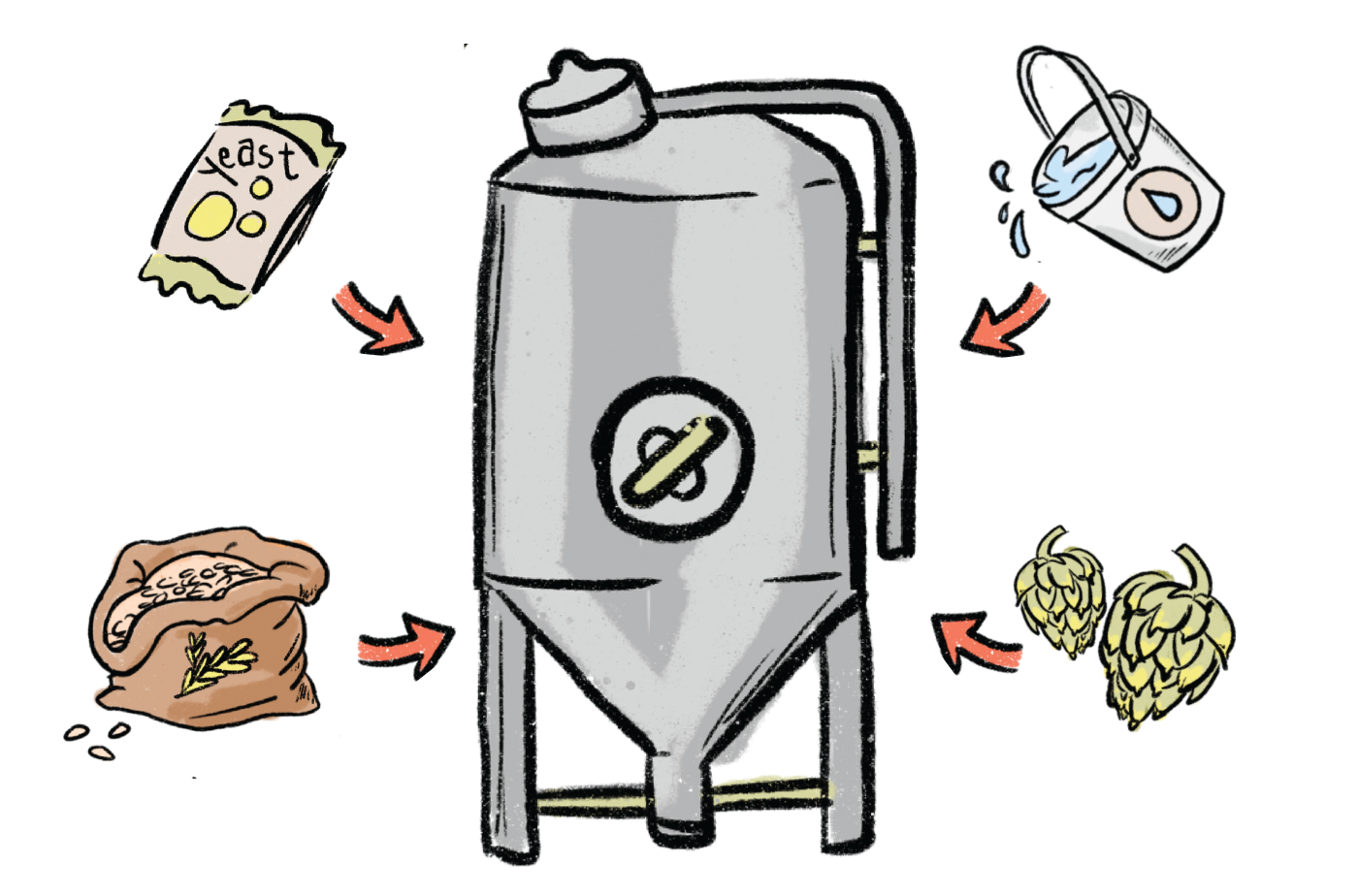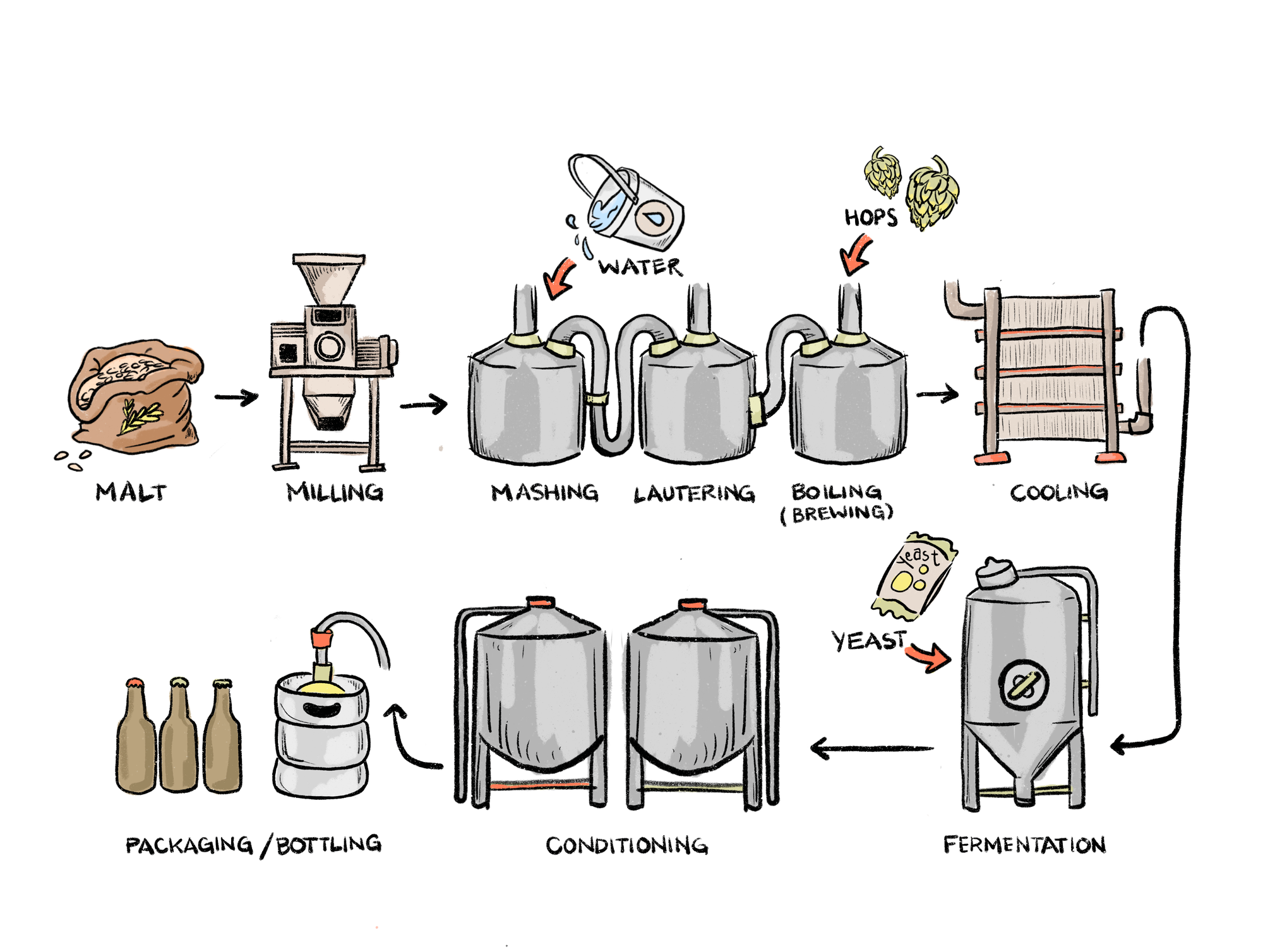

A pretty straightforward process (but don’t let grumpy brewers hear you say that)
How Beer is Made: A brief overview--earth
Beer is one of the oldest beverages on the planet, with evidence dating back to the Middle East in 10000 BCE and references to the beer as we know it (made with barley) found in Iran circa 3500 BCE. What’s fascinating is that, like wine, making beer is a pretty straightforward process (although don’t let grumpy brewers hear you say that) that takes a little bit from bread making and a little bit from wine production.
What’s in my beer?--racy
The beer ingredient list is pretty simple, really! You can make beer with just four ingredients:
- Malt (made from grains, usually barley or wheat)
- Water
- Hops
- Yeast

In fact, a famous German edict was written in 1516 called the ‘Reinheitsgebot’. aka the German purity law, which dictated that German beer can only be made from those four ingredients. The Reinheitsgebot is believed to be the world’s oldest food safety law, and any German beer that uses other ingredients can’t be labelled as bier.
Of course, much more can be added to beer (just not in Germany), and we call these adjuncts. You name it: fruit, spices, milk, chocolate, coffee, oysters! Adjuncts annoy beer purists but make the beer world exciting.
The beer production process--cellar
Roughly speaking, there are eight main steps in the beer production process. If you like, you can break that down into even more steps, but let’s not overcomplicate things before we begin!

1. Malting
The beer-making task starts with grains. Historically, that’s barley (but sometimes other grains like wheat or rice), and you want to prepare the fresh grains by soaking them in water. This kickstarts the next phase, which is grain germination (in germination boxes. No messing around with weird names here!) to help the formation of enzymes (amylase) needed for beer production. Once the grains have sprouted a little, it’s time to stick them in a kiln to dry!

2. Milling
The next step is a little bit like making flour. We feed what we’re now calling malt (but it’s called a ‘green’ malt) into a mill, which is like a big grinder. The aim is to make something soluble in water but a bit coarser than flour. What comes out from the milling is known as grist.

3. Mashing
Next comes the porridge production! Ok, it just looks a bit like porridge. Making the mash involves taking the grist and gently heating it in the mash tun (like a big sealed metal ice cooker. Homebrewers have been known to use an esky). This step is called ‘mashing-in’ and helps break down the starch in the grains and releases sugar. These malt sugars, phenolic compounds (effectively the same as tannins in wines) and protein, with the sugar used to feed the yeast in a later step. We call the result of this process the mash.

4. Lautering
Now we need a different tun (you bet it’s called the lautering tun), where the mash is filtered and separated into a sweet, watery liquid called wort, while the grain husks/solid substances sink to the bottom. These leftover solids are known as spent grains, and cows go nuts over them! The wort is the bit we keep using in the next process.

5. Boiling
Time for a go in the kettle! The boiling process is necessary to make stable beer (boiling stops enzyme activity). At this stage, we can add hops! You can use different hops for different flavours and control the hop flavour (and beer bitterness) by adjusting the amount of hops added. More hops = bitterer beer! Once the boil is done, it’s time for the whirlpool, which is much less fun than it sounds. Whirlpooling is particularly useful for picking up any other chunky bits, leaving just the wort (which we want). Usually, the wort is then cooled to keep it fresh.

6. Fermentation
Now, we have a sweet, hoppier liquid that will form the base of our beer. We transfer it to a fermentation tank, add yeast and then watch the yeast turn the sugars into alcohol to make a beer. We can use different types of yeast strains to give different beer styles, too, with the same strain used in wine (Saccharomyces cerevisiae) used to make ales, while what’s called a bottom-fermenting yeast (Saccharomyces pastorianus) to make lager.

7. Conditioning
We have a beer! Beers are typically filtered at this stage, although plenty of styles are unfiltered (especially in a modern world of hazys). Unfiltered styles require more attention to stability, especially as beer has no preservatives, but it's a fine line as filtration takes out flavour too (just like filtering wines). The finished beer also has a quick laydown in the tank, which can also help proteins and solids to fall out of the solution.

8. Packaging
Finally, when the brewer thinks the beer is finished and ready to go we put it in a can/bottle/keg/giant novelty barrel!

Doing beer differently--aromatic
Of course, we’ve just described the classic way to brew beer. We live in a wide world of beer; it all doesn't have to follow the same recipe. The use of adjuncts (any ingredient beyond grains, hops, yeast and water), plus interesting beer production tweaks, allows for a smorgasbord of different styles beyond just another lager/pale ale.
Let’s take a look at some of the important beer variations.
Sour beer
It’s funny to think about now in a world where most beer is clean and pure, but a century ago most beers were theoretically sour, largely due to poor brewery hygiene allowing other yeasts (like Brettanomyces) or naturally occurring bacteria (like Lactobacillus and Pediococcus) to flourish, all of which can make beer sour and funky. But modern techniques have helped make fresh beer a given.
But what if we want a sour and funky beer?
Lots of brewers are realising that by carefully nurturing things like Lactobacillus bacteria you can create a beer that is sour, but in a delicious way. The classical lambic ales of Belgium have been made using wild yeasts and bacteria in a style that has been made for centuries. More recently, we’ve seen an explosion in beers made using ‘lacto’ to get sourness and then with fruit additions to make these sour beers more palatable.
The best sour beers are fascinating, too. They taste like beer but with more complexity and can also age and mature like great wine. Stir in some juicy fruit, and voila! Seriously interesting drinks.
Barrel aged beer
Much like how sour beer has tapped into an ancient beer style, there has been a huge resurgence in brewers using oak barrels (yes, like winemakers) to make beer more intriguing. The lambic beers we mentioned above? Always matured in barrels. While historically barrels were used because they were good for storing liquid, these vessels also impart a flavour of their own, especially if you’re using barrels that might have previously been used to make whisky or wine.

Barrels also allow a very slow, controlled oxidation that can help mellow flavours. With powerful, alcoholic young beer, barrel aging can help soften harsh edges and lead to a harmonious drinking experience. Perhaps the only challenge with using barrels is that you can lose the freshness that would be found in beer made in a spotlessly clean metal tank.
The adjuncts
Technically, even adding bacteria is considered an adjunct (again, the pesky beer laws), and when you start chatting with a modern brewer, you realise that some throw all sorts of ingredients into their beer. Broadly speaking, however, there are a few very popular adjuncts worth talking about:
- Coffee/tea
- Chocolate/vanilla
- Bacteria
- Fruits (even the odd vegetable)
- Herbs/Spices
- Other grains and sugars
You might not realise that spices are in lots of beer, with Belgian witbier famously flavoured with coriander seeds. Lactose (which is effectively a sugar), is used in lots of beers, especially rich dark stouts, to make them taste creamier too. Fruit is everywhere in modern brewing, particularly for makers keen to make beer more approachable - a dash of mango in the boiling section we touched on above can make a fruity, hazy Pale Ale taste even more fruity.
Really, the sky is the limit when it comes to adjuncts, although the quest for balance means a heavy-handed addition can derail the pure sessionability of great beer. But in small doses? Why not! As just one crazy example, Australian brewery Mountain Culture emptied a bottle of Dom Perignon Champagne and a homebrand sponge cake into one of their famously full-flavoured beers during the production, just to celebrate the birthday of their new brew house.
Who said making beer isn’t fun?
About the Author
Andrew Graham is a master winemaker and viticulturist (aka a grape guy) who fell into the wine industry as a teenager and never looked back! Voted the 23rd most trusted wine critic on the planet, Andrew judges at wine shows across the globe and runs foolishly long ultramarathons in his spare time (swiftly followed by a recuperative glass of wine or a frosty beer).
Do you know your wine personality? If your answer is no, take our quiz to find out which wines to pick up next and build your box!
Build my box





